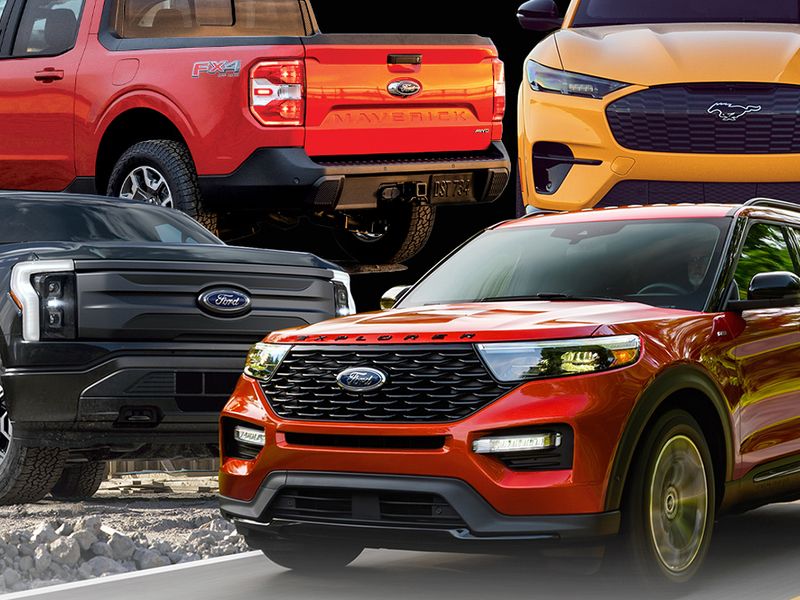
DETROIT — The products Ford Motor Co. is rolling out over the next year could make or break the automaker’s chances of becoming an electric vehicle leader long term.
After years of buildup — and with the Mustang Mach-E already stealing share from Tesla Inc. — attention now turns to the launch of the E-Transit van, due by year end, and the F-150 Lightning, slated for mid-2022. CEO Jim Farley has called the Lightning a measuring stick that will “show where EV adoption really is.”
Ford hopes to persuade customers as well as dealers to buy into EVs by focusing on well-known nameplates in popular segments and stuffing them with compelling features, software capabilities and connected services today’s models lack. That targeted strategy begins with the trio of products Ford already has revealed and will continue with an electric version of the Explorer large crossover in 2023, an expansion of the FordPass app and over-the-air updates to improve vehicles after purchase.
Company officials last week got their first chance since the coronavirus pandemic began to meet with a large number of dealers and explain that road map to the future in person at a gathering in Dallas. The multiday meeting focused on Farley’s desire to form an “always-on relationship” with customers as presenters stressed the increasingly key role of connectivity for profit margins.
“They’re going about it the right way,” said one attendee who asked not to be identified while discussing the confidential gathering. “They’re not coming out and being outlandish; they’re being smart and calculated.”
While Ford has said it hopes to have EVs represent 40 percent of global sales by 2030, executives in Dallas also acknowledged the traditional business won’t be completely upended in the near term. They vowed to continue investing in areas where dealers have traditionally raked in profits.
Ford detailed new incentives to encourage service technician retention and promised to keep its commercial EVs, which will fall under a new FordPro subsidiary, accessible to its wider dealer body — in contrast to General Motors, which plans to sell its BrightDrop electric delivery vans through separate stores that won’t necessarily be affiliated with GM dealers.
Dealers who attended the meeting drove preproduction models of the upcoming Maverick hybrid compact pickup, which Ford stressed would be a major part of future showrooms.
Andrew Frick, Ford’s vice president of sales, led most of the presentations, but Chief Marketing Officer Suzy Deering, North America COO Lisa Drake and Kumar Galhotra, president of the Americas and International Markets Group, also spoke. They addressed the roof quality problems that have stalled Bronco deliveries and detailed steps the company is taking to get dealerships more inventory amid the industry’s microchip shortage.
The officials said a plan to send dealers unfinished vehicles is on hold for now and likely won’t be implemented unless production is hampered significantly in the coming months, according to those at the meeting.
Dealers said the tone was upbeat and that they appreciated Ford’s transparency, which some had felt was missing under Farley’s predecessor, Jim Hackett, and while the pandemic prevented in-person gatherings.
“They made sure we know what their plans are,” another attendee said.
Those plans include a combination of new and redesigned electric, gasoline and hybrid models slated for production through the middle of the decade.
Along with the Explorer EV, Ford will offer an electric Lincoln Aviator, also in 2023. Both vehicles will be distinct from the standard versions and be built in Mexico.
The company’s large SUVs, the Expedition and Lincoln Navigator, will get hybrid variants within a few years as part of expected redesigns. Hybrid powertrains are also expected on popular models including the Ranger, Mustang and Ford’s Bronco family of utilities.
The Explorer and Aviator will sit on a new rear-wheel-drive and all-wheel-drive EV platform, one of two new dedicated EV architectures Ford announced in May. The other is for full-size pickups.
After the middle part of the decade, Ford could add battery-powered versions of its Bronco SUV or Ranger midsize pickup — two possibilities it hinted at in May and which would align with its focus on electrifying strong-selling, established vehicles.
“The primary advantage we have right now is the strength of our product portfolio,” Farley said last month on an earnings call. “And it’s about to get a lot stronger.”

